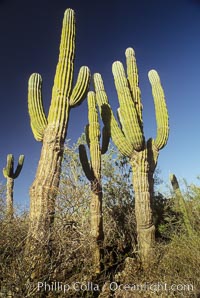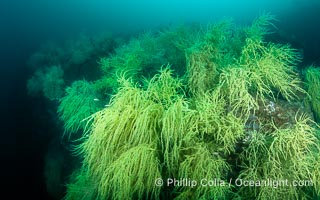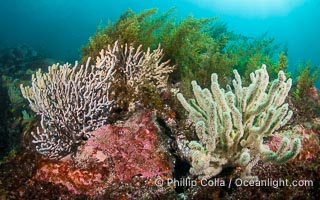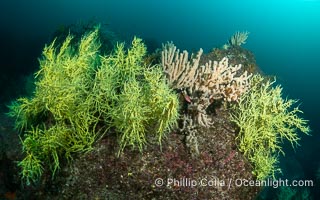
Two Divers in Huge Cavern, San Pedro Martir Island, Sea of Cortez.
Location: Isla San Pedro Martir, Sonora, Mexico
Image ID: 40389
Location: Isla San Pedro Martir, Sonora, Mexico
Image ID: 40389

Isla San Pedro Martir at sunset with extensive forest of Cardon Cactus seen on the summit ridge of the island, aerial photo, Sea of Cortez, Mexico. San Pedro Martir Island and its marine life are, since 2002, part of the San Pedro Martir Biosphere Reserve, and is regarded as a natural laboratory of adaptive evolution, similar to that of the Galapagos Islands. It is home to 292 species of fauna and flora (both land-based and aquatic), with 42 species protected by Mexican law, and 30 listed on the Red List of Threatened Species. San Pedro Martir is also unique in the area for its year-round quantity of birds. The island is the only island in the area with a perpetually swirling cloud of sea birds. This is because the water around the island, has some of the most successful marine productivity in the world.
Location: Isla San Pedro Martir, Sonora, Mexico
Image ID: 40397
Location: Isla San Pedro Martir, Sonora, Mexico
Image ID: 40397

Pink Sponges Encrusting Rocky Reef alongside various species of algae and gorgonians, San Pedro Martir Island, Sea of Cortez.
Location: Isla San Pedro Martir, Sonora, Mexico
Image ID: 40374
Location: Isla San Pedro Martir, Sonora, Mexico
Image ID: 40374

Gorgonians on Lush Rocky Reef, San Pedro Martir Island, Sea of Cortez. Gorgonians are colonial filter feeders, spreading their branches into the currents flowing over the reef in order to gather passing bits of food.
Location: Isla San Pedro Martir, Sonora, Mexico
Image ID: 40408
Location: Isla San Pedro Martir, Sonora, Mexico
Image ID: 40408

Black Coral on Rocky Reef, Unidentified species, isla San Pedro Martir, Midriff Islands, Sea of Cortez, Mexico.
Location: Isla San Pedro Martir, Sonora, Mexico
Image ID: 40411
Location: Isla San Pedro Martir, Sonora, Mexico
Image ID: 40411

Gorgonians on Lush Rocky Reef, San Pedro Martir Island, Sea of Cortez. Gorgonians are colonial filter feeders, spreading their branches into the currents flowing over the reef in order to gather passing bits of food.
Location: Isla San Pedro Martir, Sonora, Mexico
Image ID: 40415
Location: Isla San Pedro Martir, Sonora, Mexico
Image ID: 40415

Cardon cactus, near La Paz, Baja California, Mexico. Known as the elephant cactus or Mexican giant cactus, cardon is largest cactus in the world and is endemic to the deserts of the Baja California peninsula. Some specimens of cardon have been measured over 21m (70) high. These slow-growing plants live up to 300 years and can weigh 25 tons. Cardon is often mistaken for the superficially similar saguaro of Arizona and Sonora, but the saguaro does not occupy Baja California.
Species: Cardon cactus, Elephant cactus, Pachycereus pringlei
Location: La Paz, Baja California, Mexico
Image ID: 05498
Species: Cardon cactus, Elephant cactus, Pachycereus pringlei
Location: La Paz, Baja California, Mexico
Image ID: 05498

Isla San Pedro Martir at sunset with extensive forest of Cardon Cactus seen on the summit ridge of the island, aerial photo, Sea of Cortez, Mexico. San Pedro Martir Island and its marine life are, since 2002, part of the San Pedro Martir Biosphere Reserve, and is regarded as a natural laboratory of adaptive evolution, similar to that of the Galapagos Islands. It is home to 292 species of fauna and flora (both land-based and aquatic), with 42 species protected by Mexican law, and 30 listed on the Red List of Threatened Species. San Pedro Martir is also unique in the area for its year-round quantity of birds. The island is the only island in the area with a perpetually swirling cloud of sea birds. This is because the water around the island, has some of the most successful marine productivity in the world.
Species: Cardon cactus, Elephant cactus, Pachycereus pringlei
Location: Isla San Pedro Martir, Sonora, Mexico
Image ID: 40398
Species: Cardon cactus, Elephant cactus, Pachycereus pringlei
Location: Isla San Pedro Martir, Sonora, Mexico
Image ID: 40398

Black Coral on Rocky Reef, Unidentified species, Midriff Islands, Sea of Cortez, Mexico.
Location: Isla San Pedro Martir, Sonora, Mexico
Image ID: 40393
Location: Isla San Pedro Martir, Sonora, Mexico
Image ID: 40393

California Sea Lion, San Pedro Martir Island, Sea of Cortez, Mexico.
Species: California sea lion, Zalophus californianus
Location: Isla San Pedro Martir, Sonora, Mexico
Image ID: 40395
Species: California sea lion, Zalophus californianus
Location: Isla San Pedro Martir, Sonora, Mexico
Image ID: 40395

Turtle Flies Over Pink Sponges Encrusting Rocky Reef alongside various species of algae and gorgonians, San Pedro Martir Island, Sea of Cortez.
Location: Isla San Pedro Martir, Sonora, Mexico
Image ID: 40416
Location: Isla San Pedro Martir, Sonora, Mexico
Image ID: 40416

Black Coral on Rocky Reef, Unidentified species, isla San Pedro Martir, Midriff Islands, Sea of Cortez, Mexico.
Location: Isla San Pedro Martir, Sonora, Mexico
Image ID: 40426
Location: Isla San Pedro Martir, Sonora, Mexico
Image ID: 40426

California Sea Lion, San Pedro Martir Island, Sea of Cortez, Mexico.
Species: California sea lion, Zalophus californianus
Location: Isla San Pedro Martir, Sonora, Mexico
Image ID: 40428
Species: California sea lion, Zalophus californianus
Location: Isla San Pedro Martir, Sonora, Mexico
Image ID: 40428

Pacific Green Sea Turtle, Chelonia mydas, grazing on marine algae, San Pedro Martir Island, Sea of Cortez.
Location: Isla San Pedro Martir, Sonora, Mexico
Image ID: 40429
Location: Isla San Pedro Martir, Sonora, Mexico
Image ID: 40429

Extensive Forest of Cardon Cactus on the Summit Ridge of San Pedro Martir Island, Sea of Cortez, Mexico. The island and its marine life are, since 2002, part of the San Pedro Martir Biosphere Reserve, and is regarded as a natural laboratory of adaptive evolution, similar to that of the Galapagos Islands. It is home to 292 species of fauna and flora (both land-based and aquatic), with 42 species protected by Mexican law, and 30 listed on the Red List of Threatened Species. San Pedro Martir is also unique in the area for its year-round quantity of birds. The island is the only island in the area with a perpetually swirling cloud of sea birds. This is because the water around the island, has some of the most successful marine productivity in the world.
Location: Isla San Pedro Martir, Sonora, Mexico
Image ID: 40386
Panorama dimensions: 3391 x 10022
Location: Isla San Pedro Martir, Sonora, Mexico
Image ID: 40386
Panorama dimensions: 3391 x 10022

Isla San Pedro Martir aerial photo, Sea of Cortez, Mexico. San Pedro Martir Island and its marine life are, since 2002, part of the San Pedro Martir Biosphere Reserve, and is regarded as a natural laboratory of adaptive evolution, similar to that of the Galapagos Islands. It is home to 292 species of fauna and flora (both land-based and aquatic), with 42 species protected by Mexican law, and 30 listed on the Red List of Threatened Species. San Pedro Martir is also unique in the area for its year-round quantity of birds. The island is the only island in the area with a perpetually swirling cloud of sea birds. This is because the water around the island, has some of the most successful marine productivity in the world.
Location: Isla San Pedro Martir, Sonora, Mexico
Image ID: 40419
Location: Isla San Pedro Martir, Sonora, Mexico
Image ID: 40419

Offshore Islets of San Pedro Martir Island, Sea of Cortez. Small rocky islets around the larger Midriff Islands in the Sea of Cortez offer some of the best diving in the Sea of Cortez with a rich variety of invertebrate and fish life.
Location: Isla San Pedro Martir, Sonora, Mexico
Image ID: 40423
Location: Isla San Pedro Martir, Sonora, Mexico
Image ID: 40423

Desert iguana, one of the most common lizards of the Sonoran and Mojave deserts of the southwestern United States and northwestern Mexico.
Species: Northern desert iguana, Dipsosaurus dorsalis
Location: Joshua Tree National Park, California
Image ID: 26728
Species: Northern desert iguana, Dipsosaurus dorsalis
Location: Joshua Tree National Park, California
Image ID: 26728

Gorgonians on Lush Rocky Reef, San Pedro Martir Island, Sea of Cortez. Gorgonians are colonial filter feeders, spreading their branches into the currents flowing over the reef in order to gather passing bits of food.
Location: Isla San Pedro Martir, Sonora, Mexico
Image ID: 40377
Location: Isla San Pedro Martir, Sonora, Mexico
Image ID: 40377

Gorgonians on Lush Rocky Reef, San Pedro Martir Island, Sea of Cortez. Gorgonians are colonial filter feeders, spreading their branches into the currents flowing over the reef in order to gather passing bits of food.
Location: Isla San Pedro Martir, Sonora, Mexico
Image ID: 40385
Location: Isla San Pedro Martir, Sonora, Mexico
Image ID: 40385

Gorgonians on Lush Rocky Reef, San Pedro Martir Island, Sea of Cortez. Gorgonians are colonial filter feeders, spreading their branches into the currents flowing over the reef in order to gather passing bits of food.
Location: Isla San Pedro Martir, Sonora, Mexico
Image ID: 40387
Location: Isla San Pedro Martir, Sonora, Mexico
Image ID: 40387

Black Coral and Gorgonians on Rocky Reef, San Pedro Martir Island, Mexico.
Location: Isla San Pedro Martir, Sonora, Mexico
Image ID: 40390
Location: Isla San Pedro Martir, Sonora, Mexico
Image ID: 40390

Black Coral and Gorgonians on Rocky Reef, San Pedro Martir Island, Mexico.
Location: Isla San Pedro Martir, Sonora, Mexico
Image ID: 40392
Location: Isla San Pedro Martir, Sonora, Mexico
Image ID: 40392

Pink Sponges Encrusting Rocky Reef alongside various species of algae and gorgonians, San Pedro Martir Island, Sea of Cortez.
Location: Isla San Pedro Martir, Sonora, Mexico
Image ID: 40417
Location: Isla San Pedro Martir, Sonora, Mexico
Image ID: 40417

Rugged Terrain of Isla San Pedro Martir, Sea of Cortez. Aerial photo. The large bird population deposits enormous quantities of guano on the island, resulting in the white appearance of the island contrasted with sparse vegetation. In the late 19th and early 20th century guano was heavily mined off the island and shipped as far as Europe for use as fertilizer. San Pedro Martir is seldom visited, having near vertical sides leaving only questionable fair weather anchorages in two locations. Landing access was possible near a small isthmus in the southeast of the island, but is now forbidden. In 2005, the island was classified along with 244 others as a World Heritage Site by UNESCO, and included in the Islands and Protected Areas of the Gulf of California.
Location: Isla San Pedro Martir, Sonora, Mexico
Image ID: 40400
Location: Isla San Pedro Martir, Sonora, Mexico
Image ID: 40400

Rugged Terrain of Isla San Pedro Martir, Sea of Cortez. Aerial photo. The large bird population deposits enormous quantities of guano on the island, resulting in the white appearance of the island contrasted with sparse vegetation. In the late 19th and early 20th century guano was heavily mined off the island and shipped as far as Europe for use as fertilizer. San Pedro Martir is seldom visited, having near vertical sides leaving only questionable fair weather anchorages in two locations. Landing access was possible near a small isthmus in the southeast of the island, but is now forbidden. In 2005, the island was classified along with 244 others as a World Heritage Site by UNESCO, and included in the Islands and Protected Areas of the Gulf of California.
Location: Isla San Pedro Martir, Sonora, Mexico
Image ID: 40421
Panorama dimensions: 4451 x 10130
Location: Isla San Pedro Martir, Sonora, Mexico
Image ID: 40421
Panorama dimensions: 4451 x 10130

Desert iguana, one of the most common lizards of the Sonoran and Mojave deserts of the southwestern United States and northwestern Mexico.
Species: Northern desert iguana, Dipsosaurus dorsalis
Location: Joshua Tree National Park, California
Image ID: 26735
Species: Northern desert iguana, Dipsosaurus dorsalis
Location: Joshua Tree National Park, California
Image ID: 26735

Desert iguana, one of the most common lizards of the Sonoran and Mojave deserts of the southwestern United States and northwestern Mexico.
Species: Northern desert iguana, Dipsosaurus dorsalis
Location: Joshua Tree National Park, California
Image ID: 26755
Species: Northern desert iguana, Dipsosaurus dorsalis
Location: Joshua Tree National Park, California
Image ID: 26755

Desert iguana, one of the most common lizards of the Sonoran and Mojave deserts of the southwestern United States and northwestern Mexico.
Species: Northern desert iguana, Dipsosaurus dorsalis
Location: Joshua Tree National Park, California
Image ID: 26761
Species: Northern desert iguana, Dipsosaurus dorsalis
Location: Joshua Tree National Park, California
Image ID: 26761

Desert iguana, one of the most common lizards of the Sonoran and Mojave deserts of the southwestern United States and northwestern Mexico.
Species: Northern desert iguana, Dipsosaurus dorsalis
Location: Joshua Tree National Park, California
Image ID: 26769
Species: Northern desert iguana, Dipsosaurus dorsalis
Location: Joshua Tree National Park, California
Image ID: 26769